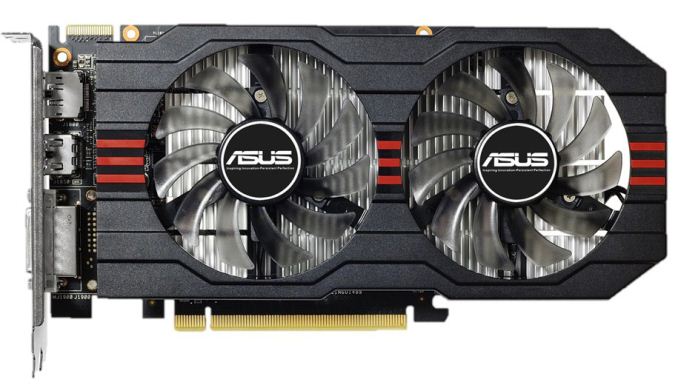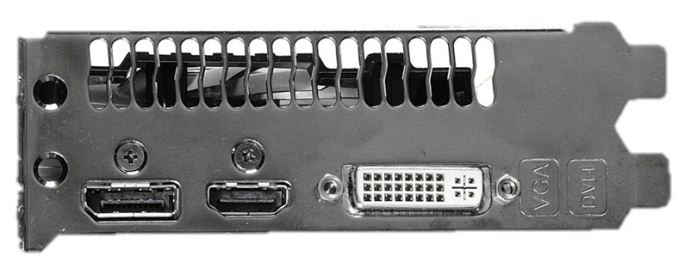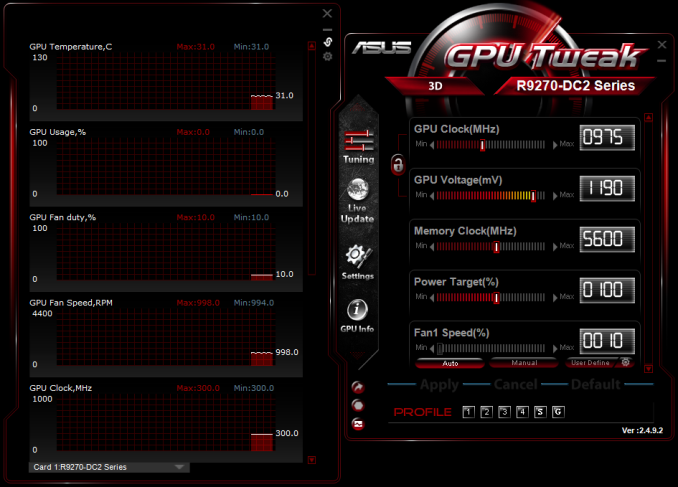The AMD Radeon R7 265 & R7 260 Review: Feat Sapphire & Asus
by Ryan Smith on February 13, 2014 8:00 AM ESTMeet The Asus Radeon R7 260
Our other card of the day is our R7 260 sample from AMD, which comes in the form of a complete retail card: Asus’s Radeon R7 260. This is a standard retail card, featuring a solid design but no factory overclock or other frills.
Surprisingly for a 95W card, Asus’s card is a dual fan open air design. Based on a variation of their dual fan coolers, Asus utilizes a relatively simple aluminum heatsink directly mounted to the Bonaire GPU beneath. This heatsink has a large base that serves to cover the RAM, but not the VRMs towards the front of the card, and mushrooms out at the top to form a larger surface for the dual fans to cool. Truth be told we were pleasantly surprised by this design; these larger dual fan designs are uncommon for sub-100W cards, and even with the relatively simple heatsink it’s essentially oversized for the GPU in question, though as we’ll see in our noise results this is clearly to the benefit of the user.
As a result of using such a large cooler on such a small board, the Asus R7 260’s cooler significantly overhangs the PCB. The PCB itself is just 6.8” long, while the cooler extends a further 1.9” to give the card a total length of 8.7”. As is usual for Asus, the card feature’s Asus’s Super Alloy Power discrete electrical components for enhanced durability. Meanwhile the fact that this is closer to a card strapped to a cooler than a cooler strapped to a card doesn’t do Asus any favors, especially since the GPU is towards the rear of the card. The short length of the card ensures it’s rigid enough, but there’s some opportunity for flexing towards the front of the card.
For Asus’s power connectivity, the single 6-pin PCIe power socket is found at the end of the card, orientated parallel to the PCB despite the significant overhang of the cooler. To make up for this, Asus has once again reversed the PCIe power socket so that the tab on the plug faces inwards instead of outwards, which makes this design practical as the cooler no longer blocks the tab.
As for Asus’s display I/O, Asus is using a simpler port layout that occupies just a single slot, presumably so that this PCB is capable of being used on single-slot designs if necessary. This results in the card having 1x DL-DVI, 1x HDMI, and happily enough for such a low-end card, 1x DisplayPort, as opposed to a VGA port. This gives the Asus card the ability to drive three digital displays at once for Eyefinity, or even a single 4K display if we’re talking about simple desktop work.
Meanwhile on the software side of things the R7 260 comes with Asus’s standard GPUTweak software utility. GPUTweak is a very competent overclocking suite that offers all of the overclocking and monitoring functionality we’ve come to expect from a good overclocking utility, including a wide array of monitoring options and support for GPU voltage control. Asus’s taste in skins is unfortunate – a low contrast red on black – but otherwise the UI itself is similarly solid. To that end GPU Tweak won’t match Afterburner on some of its more fringe features such as recording and overlays, but as a pure overclocking utility it stands up rather nicely.
Wrapping things up, as one of the only two R7 260 graphics cards currently Asus is both enjoying and being disrupted by the lack of sensible pricing among R7 260 cards. At a current retail price of $139 the Asus R7 260 is a full $30 (28%) over what should be a $109 MSRP for an R7 260 card, and $15 more expensive than the alternative MSI card. More importantly, it’s currently just as expensive as the more powerful R7 260X, which puts this card in an unfortunate spot since you can easily buy a more powerful card for less. Asus can enjoy a small premium from a good design and their 3 year warranty, but this is an especially treacherous position if R7 260X prices quickly come down to $119.
Finally, on a quick technical note we do want to point out that we have encountered one minor oddity with the Asus R7 260 that as of this writing is still being looked into by AMD. The card we received has its GPU idle clockspeed at 550MHz, instead of the 300MHz clockspeed that is common for all other AMD GCN cards, including their other Bonaire cards. The ramifications of this are minimal as it doesn’t affect the load performance of the card in any way, but it does mean the card is technically running at a higher clockspeed than it should at idle, which can affect idle power consumption. We’re seeing 74W at the wall, the same as our reference R7 260X, but our GPU testbed is admittedly not well suited to picking up small fluctuations in idle power consumption like this on such a low powered card. In any case we don’t believe it to be a dealbreaker, but AMD is currently looking into it to try to determine what’s going on.














52 Comments
View All Comments
edzieba - Thursday, February 13, 2014 - link
It's not just a tool for flagging up multi-screen/multi-GPU stutter issues. By showing the distribution of frame times, you can tell the difference between two cards that both average 50fps, but where one delivers every frame in 20 +/- 1 ms, and the other at +/- 5. The latter will deliver a much smoother output, which is not apparent from a single-number metric.Anandtech readers are a pretty smart bunch. We'd much prefer Graph Overload to too little information, particularly when other sites provide the additional information as standard.
Death666Angel - Thursday, February 13, 2014 - link
Sounds like the first (+/- 1 ms) would deliver the smoother experience than the latter (+/- 5 ms). :)edzieba - Monday, February 17, 2014 - link
Urp, that's what I /meant/ to write...Cellar Door - Thursday, February 13, 2014 - link
This rebadge game is terrible. Both parties are guilty here but the fact that these products get reviewed on regular basis just makes no sense.Here is a proper review of the of the 265 and 260: Lets confuse everyone with new nomenclature and what basically is a 7850 from close to 2 years ago. These cards are nothing but cash cows for the mainstream.
This card is being launched to draw attention to AMD just before the GTX 750 Ti comes to the market, its nothing but emptying the stocks of poor quality chips.
MrSpadge - Thursday, February 13, 2014 - link
Guess what: they wouldn't build GPUs if they wouldn't expect them to be cash cows!EnzoFX - Thursday, February 13, 2014 - link
THis has always been the case in the not-high-tier cards. Where have you been? I love these cards. What's wrong with an "update" to tried and true cards. I love these single-pcie-power cards. Besides, most games will prob still be targeting this level of power considering it's comparable to the new consoles.Death666Angel - Thursday, February 13, 2014 - link
First time I can remember there being rebadging was with the 8xxx / 9xxx series from nVidia, before that I don't remember it happening.LordOfTheBoired - Friday, February 14, 2014 - link
GeForce4 MX was a modified GeForce2. While not a straight same-component relabel, it WAS intentionally-misleading branding meant to make people think it was an upgrade from the GeForce 3 rather than a downgrade, and was very much in the spirit of the modern rebadge.That's the earliest example that springs to mind here.
rallyhard - Friday, February 14, 2014 - link
I agree that your example, the GeForce4 MX is one of the earliest, and probably one of the most misleading rebrands ever.The first video card I ever purchased was a rebrand that occurred a year earlier, though: the lowly Radeon 7000. It was the exact same card as the previous RV100-based Radeon LE, but they gave it a flashy new name when they introduced the new Radeon 7500 with the RV200 chip.
silverblue - Friday, February 14, 2014 - link
The GeForce 4 MX was probably a worse release than the 2 MX in that the latter was indeed based on the GeForce 2, but lacked the hardware transform and lighting capabilities of the GeForce 2 GTS and the earlier GeForce 256. The GeForce 2 MX 400 was the only model that had a chance of beating the 256 DDR.The Radeon 9000 was a hacked down 8500 LE, but I suppose considering the low number in the 9xxx series, there had to be a low-end part. Besides which, it did still have T&L.
I can't think of any straight rebrands from back then apart from the 7000.